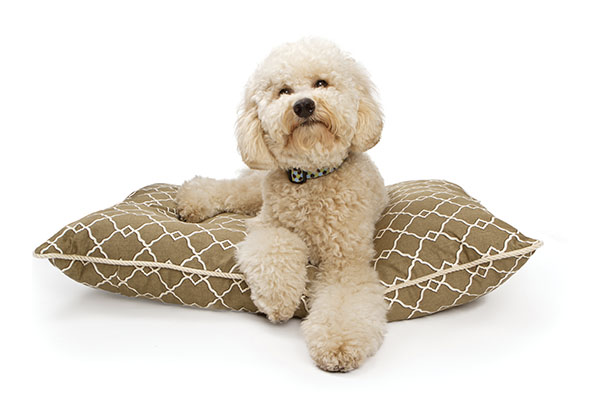Chapter 4: K-Knocking People Over

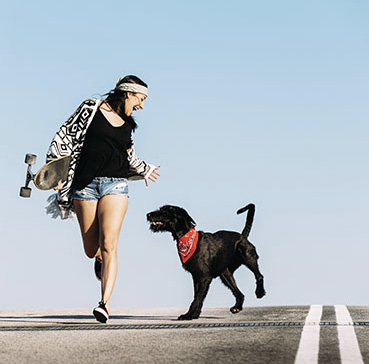
Keep Your Paws to Yourself
You’ve probably noticed that some dogs don’t have much regard for personal space. But muddy paws have no place on the neighbor’s dry-clean-only blazer, and large dogs who jump can present a danger to kids or the elderly. So I have a zero-tolerance policy related to jumping, and that includes all friends and family members, even the ones who like when dogs jump on them. Allowing Leroy to jump on some but not all people is confusing and unfair to him; how can you expect him to follow the rule when the rule changes? In situations like this, Grandma will inevitably be knocked over, and Leroy will wonder what kind of strange world he is living in, where he is rewarded with attention when he jumps on some people but punished for jumping on others.
Can you still pet your dog and show your affection? Of course! Isn’t that why you got a dog in the first place? This chapter will give you several management and training strategies to teach your dog that he gets all the attention he wants when he’s being polite, with four paws firmly on the ground. Polite greetings are a win-win for both dog and human. The strategies for the first problem in this chapter pertain to outdoor scenarios, while the second problem focuses on indoor jumping.
Note that these strategies are intended for dogs who jump because they are overly enthusiastic greeters. These strategies should not be used on dogs who are lunging at or jumping on people in an unfriendly way (as if to say “Back off!”), nor should these strategies be used on shy dogs who jump on their handlers because they are afraid of something in their surroundings.
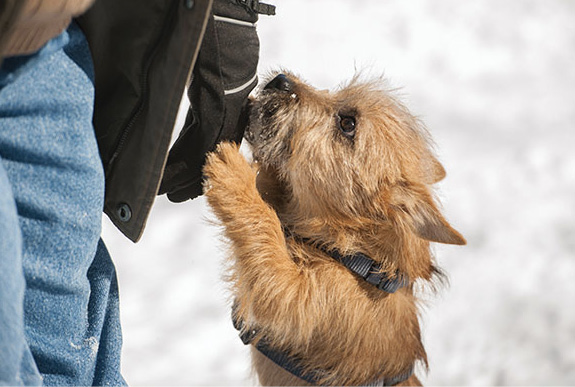
Even with small dogs, jumping up can be a problematic behavior.

When I’m walking my dog, he jumps on every person who walks by.
Management Strategy 1: Practice Your “New Yorker Walk”
The New Yorker walk is the gait of a person on a mission. It sends a clear message to both your dog and to other people on the street that you aren’t interested in stopping for small talk. When you see a potential distraction up ahead, such as a stranger or another dog, start your New Yorker walk ahead of time to prevent an interaction your dog isn’t calm enough to handle.
The New Yorker walk has four components:
- Body-block the dog. This means you’ll put yourself between the dog and any distraction. For many dogs, using your body as a barrier sends the message that they won’t physically be able to jump on the oncoming person, so they don’t even try. This strategy works for other distractions, as well. You can body-block between your dog and another dog, a kid on a skateboard, or a squirrel hopping along your route.
- Have a short enough leash that the dog can’t swerve and drag you. I recommend tying a knot in your leash about midway, or closer to the clip for taller dogs. This allows you to immediately get into New Yorker mode by grabbing the knot, so you have the perfect leash length without any fumbling. (You can also buy a leash with an additional handle built in near the clip.)
- Avoid eye contact with the approaching person. This is a time-tested New York solution to preventing all kinds of awkward confrontations. If a full snub is too coldhearted for you, cast your eyes toward your dog when passing someone and gently tell your pup how well he’s behaving. This gives people the impression that you’re training (which you are!), and passersby are unlikely to interfere.
- Set a fast pace and don’t slow down. Don’t stroll like a tourist; be on a mission!
Management Strategy 2: Step on the Leash
This one is simple. Provided that your leash is long enough (and a regular 6-foot lead will suffice), you will step on the middle portion of the leash so your dog physically can’t jump up. The intention is not to hurt the dog, so refer to the equipment section of Chapter 5 to make sure your dog is wearing a safe harness or collar for this activity. The purpose is simply to stop the undesirable behavior—to break the habit of jumping. Since jumping on people is inherently fun for dogs, the behavior becomes more firmly ingrained in the dog’s repertoire with every jump. What starts as an experiment quickly becomes habitual and, thus, harder to break. And, as you’ve probably learned, strangers are generally terrible at following your instructions not to pet your jumping dog. These well-meaning people further reinforce the dog’s jumping by rewarding him with attention when he jumps on them. Consequently, the responsibility all falls to you, the handler, to keep your pup from jumping.
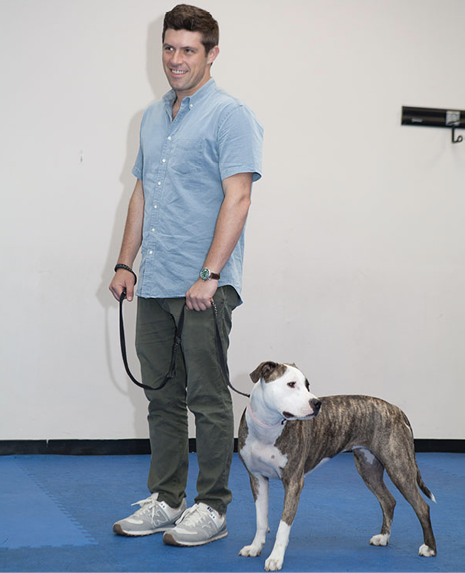
▲ Joe and Susu show us the appropriate leash length for the New Yorker Walk. It has a little slack but does not give Susu the freedom to swerve around her handler.
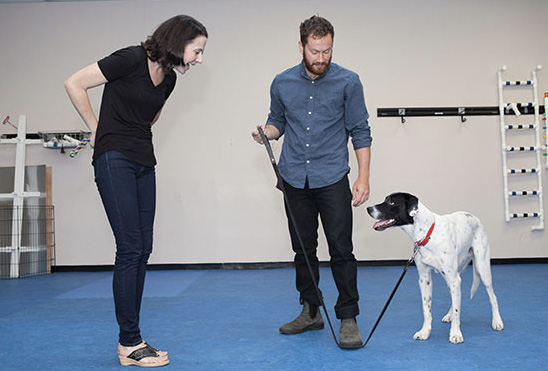
▲ Jacob steps on the leash so that Finn can comfortably stand but not jump up to greet the “friendly stranger.” Be ready to implement this management technique before your dog starts to jump.
How to Step on the Leash
- When you cannot avoid a greeting, pull over and collect yourself before the stranger approaches. Don’t wait for your dog to start going bonkers.
- Step on a midway point of your leash so that your dog can comfortably stand but not jump up.
- Once you’ve prevented your dog from jumping, the stranger can reach down to pet him.
This technique is only a temporary fix for dogs in the early stages of learning not to jump, and it can be used in conjunction with the training strategies that follow. Once your dog has developed more self-control through training, you will no longer need to step on the leash.
Training Strategy 1: Four on the Floor
This training strategy is best if you have family members or friends who can help you practice. You’re going to teach your dog that all the attention from humans comes when he has four paws firmly on the floor. The moment his front paws start flailing, the attention stops and the person walks away. Bummer! The best part about this strategy is that the person’s attention is the reward, so it’s calorie-free training with no need for treats.
How to Teach Four on the Floor
This exercise requires two people, one holding the dog on leash and one acting as a “friendly stranger” who approaches the dog. The dog and his handler remain still, while the friendly stranger will move toward the dog. The following instructions are for the friendly stranger; the handler does not need to do anything.
- Walk toward the dog calmly. If the dog is very excitable, don’t make eye contact.
- If the dog rears up at any point, turn and walk away. His actions just lost him the chance to get your attention.
- If the dog has four paws on the floor, reward him with gentle petting. If he jumps up during the petting, game over! Walk away.
Once your dog can handle a calm approach for four repetitions in a row, you can gradually intensify your excitement level. These are some possible steps:
- Make eye contact and smile at the dog as you approach. Get four-for-four.
- If that goes well, talk to him a little as you get closer. Get four-for-four.
- Talk gently to him and use low, inviting body language with slightly outstretched arms. Get four-for-four.
- Continue making your approaches more enthusiastic by adding more sound or expressive body language.
Each person who practices should follow the same routine, starting with a calm approach. Dogs don’t generalize well, so you’ll need to practice this with several different people until your dog realizes, Ohhh, you mean this rule applies to all humans! See the Appendix for a sample plan and chart to help you track your progress when training Four on the Floor.
Troubleshooting
Problem: My dog can’t sit still even when I calmly approach.
Solution: Lower your criteria. With extra-bouncy dogs, sometimes you have to start by walking toward him in an indirect, curving path, similar to how polite dogs greet each other. Swing a wide loop toward the dog so you actually make contact with him by approaching his shoulder rather than his head. Avoid eye contact and try to keep your arms still or folded. Essentially, try to be as boring as possible.
Training Strategy 2: Sit for Greeting
If Four on the Floor is a little too complicated for your friends and family, don’t despair. This next strategy only requires one person—you—to be on the ball. In this scenario, the dog must remain sitting while a friendly stranger approaches. Because, initially, this will be difficult for your dog to do, use delicious treats to reward him for his hard work.
Sitting to greet is an example of what trainers call “teaching an incompatible behavior.” If your dog is sitting when a stranger approaches, by default he isn’t jumping or lunging (he can’t sit and jump at the same time). You have successfully stopped the rude behavior without using force, and you’ve reinforced how rewarding it is to be polite instead. With consistency, you will have a dog that sees a stranger and automatically sits in anticipation of a greeting.
The goal of this exercise is to condition your dog to look to you when a person approaches. Rather than thinking, Woohoo! Someone to jump on!, we want him to think, Woohoo! Someone’s coming! Time to look at my human and sit for goodies! To make the connection that strangers equal goodies, you will start this activity at the moment your dog sees the stranger approaching. Don’t wait for your dog to start jumping and pulling toward the person; you’ve already lost his attention at that point. Rather, if you ask for the polite behavior before your dog starts to lose control, you are preventing the problem from even starting and teaching a calmer, more polite greeting routine.
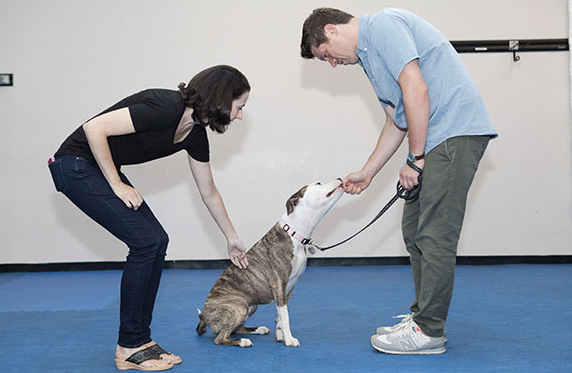
While the “stranger” pets Susu, Joe gives her several pieces of cheese. Susu is much more interested in the cheese than the stranger; with a little practice, she’ll learn that sitting for strangers is more rewarding than jumping on them.
How to Teach Sit for Greeting
Though the instructions below use the word stranger to describe an approaching person, this strategy works just as well with people your dog already knows.
- The moment your dog notices a stranger approaching on the sidewalk, tell him to sit. If he is already excited, you might need to lure him into the Sit by putting the treat in front of his nose. That’s fine in the beginning.
- As the stranger approaches, continue treating as frequently as needed. At first, it will probably look like a rapid-fire treat-treat-treat with few or no pauses in between.
- When the stranger reaches you, it’s up to you if she can pet your pooch. Don’t feel obligated to let it happen. Remember that your responsibility is to your dog, not to a passerby who you will never see again. A quick, “Sorry, we’re training” and then breaking eye contact with the person is perfectly acceptable.
- If you agree to the petting, continue the rapid-fire treating through the encounter. Don’t worry if your dog gets up and stands at this point, as long as all four paws are on the ground.
- The moment the interaction is over, stop treating and briskly walk away on a short leash. Don’t give your dog the chance to try to follow, nip at, or jump on the person as she walks away.

Once your dog starts to figure out that an approaching stranger signals treats, he will see a stranger coming and, rather than fixate on this new friend, will look at you. This means he’s catching on. Good dog! While he’s looking at you, ask him for a Sit and start rewarding—but how much should you reward once he starts to figure out the “game”? Let’s say your dog can sit through the encounter with the strangers (or at least sit while the person approaches and stand up for the actual petting, if you allow it). You can now start to reduce how frequently you have to treat your pooch to keep his rear on the ground and his focus on you. As time goes on, your rapid-fire treating will become treat-pause-treat-pause-treat. Once your dog can ace short pauses between treats, reduce it to treat-pause-pause-treat-pause-pause-treat. With time and repetition, the pauses get longer and longer as the dog gains more self-control.
Work at your dog’s pace as you increase the pauses between treats; for some dogs, it might take only a few sessions, or, for a dog or puppy like Pogo (described in the Introduction), it could take several weeks. When it comes to reducing your treats, don’t rush it. If your dog starts breaking his Sit, it means you have reduced the frequency of treats too quickly, and he has become confused. See the Appendix for a sample plan and chart to help you track your progress when training Sit for Greeting.
Troubleshooting
Problem: My dog can’t sit still. He keeps popping up.
Solution: There are three possible reasons and solutions.
- Your rate of reinforcement (how frequently you treat) needs to be more rapid-fire. If your dog loses focus when you pause between treats, it means your pauses are too long. Just as children learn the alphabet before they can build longer words or sentences, many dogs need to begin with a foundation of continuous treats to keep them focused before they can handle longer pauses between treats.
- You need higher-level treats. Make sure you’re treating with something delicious, like pieces of chicken, hot dogs, or string cheese, as frequently as it takes to keep your dog focused on you. Kibble might work when training indoors or in low-distraction environments, but if your dog isn’t interested in his kibble when you’re training around distractions, it’s a clear signal that he needs better payment for the effort he’s putting in.
- Your dog can’t yet handle sitting in this level of distraction. At this point, start practicing Sit outdoors when there are no distractions so he learns how much fun it is to sit on cue. Repeat it so often that sitting becomes a part of your dog’s repertoire. Meanwhile, use the management strategies in this chapter when you’re passing people on the street so your dog isn’t given the opportunity to jump on passersby. Once your dog responds consistently to the Sit cue on your walks, you can ask him to sit in the presence of distractions, such as approaching strangers.
Problem: My dog will sit for some people but not others.
Solution: Be selective. Not all strangers are suitable to greet your dog, particularly excited kids and those overly enthusiastic “it’s-OK-I-love-all-dogs” adults. Sometimes, looking out for your dog’s best interests means snubbing a human (politely, of course). But, let’s face it—those humans don’t think twice about undoing all your hard work by encouraging your dog to jump, so don’t feel badly if you ask them to keep on walking.
Training Strategy 3: Let’s Shake on It
Perhaps your pup is the life of the party, making human friends wherever he goes. It’s understandable that you don’t want to take away all of his social interaction. One way to harness your dog’s exuberance is to teach him a cool interactive trick that is incompatible with jumping. My favorite, and often the easiest to train, is Shake (or Give Paw). The beauty of Shake is that it allows both parties, the dog and the human, to interact politely with each other. If your dog can shake for a new friend, he can’t simultaneously be jumping, and the person on the receiving end of the shake will have no need to encourage your dog to jump up. Win-win! Many dogs love this behavior and offer it to everyone without even being cued.
How to Teach Shake
There are many ways to teach this behavior, and here I explain two different ways. I recommend trying the former method first because it requires your dog to figure out Shake for himself.
- Ask your dog to sit.
- Hide a treat in one hand. Extend that hand with your palm up, but in a loose fist to protect the treat, to the sitting dog.
- Ignore any mouthing at your hand. When the dog paws at your hand, mark and reward.
- Get four-for-four.
- Add the cue “Shake” right before you present your fist. Get four-for-four.
- Remove the treat from your fist and put it in your other hand, which is hidden behind your back. Say “Shake” and extend your empty fist. When he shakes, reward from your other hand. Get four-for-four.
- Gradually open your cue hand. Take it slowly, opening your palm an inch or so more each time you give the Shake cue. If you go immediately from a fist to a flat palm, your dog probably won’t understand this dramatically different cue. If your dog gets stuck, go back to the previous step (a tighter fist) and get four-for-four.
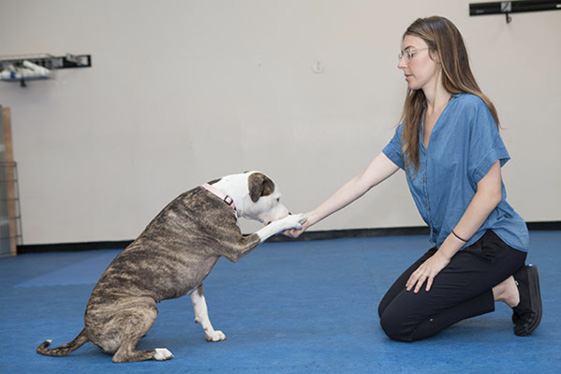
▲ Ilyssa presents a treat in her fist, palm up. At first, Susu just wants the treat, so she licks and paws at the fist. The moment Susu’s paw touches Ilyssa’s hand, it magically opens, and Susu gets the treat. (Hold your fist where your dog can easily paw at it.)
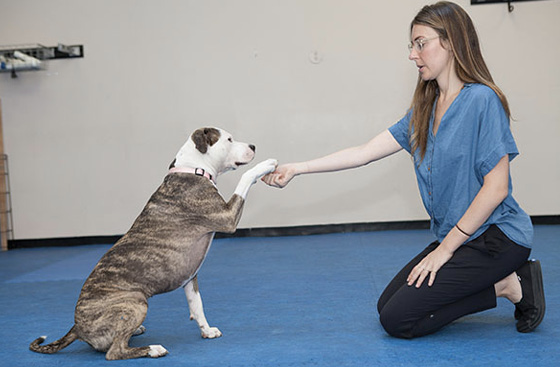
▲ Susu is getting the idea. At Step 6, Ilyssa’s fist is empty; she will reward Susu with a treat hidden in her pocket.

▲ At Step 7, Ilyssa has started with each rep.
The following method works for dogs whose paws seem glued to the ground. It’s less desirable than the foregoing method because you’re doing the work for the dog, which doesn’t help build his independent-thinking skills.
- Ask your dog to sit.
- Extend one hand, palm up, in the Shake gesture. Meanwhile, with your other hand, tap the back of one of the dog’s lower front legs.
- When he feels the pressure of your tap and lifts the leg up, let his paw briefly touch or rest in your outstretched palm. Mark and reward. Get four-for-four.
- Add the cue “Shake” before this sequence, so it is “Shake,” present your open palm, lightly tap the back of the leg, and mark and reward when the dog’s paw touches your palm. Get four-for-four.
- With each rep, tap the back of your dog’s leg more lightly each time until you don’t need to tap at all.
Troubleshooting
Problem: My dog is too excited to shake strangers’ hands.
Solution: Rome wasn’t built in a day, so be patient. Start practicing this in low-distraction areas, with just you and the dog. Practice with friends and family indoors before testing it outdoors. When you do transfer Shake to outdoor scenarios, your dog might be too distracted to focus, so start from the beginning and work your way back up. Outside, cue your dog to shake with you and with others he already knows so that his excitement level is manageable. With time and practice, your dog will generalize the behavior, which means he’ll be able to do it in all different situations as well as with new people.
Remember, the more you reward a behavior, the more often a dog will do it. If Shake gets the dog a lot of cookies and attention, it can become his default behavior around new people. And then you become the coolest dog owner on the block.
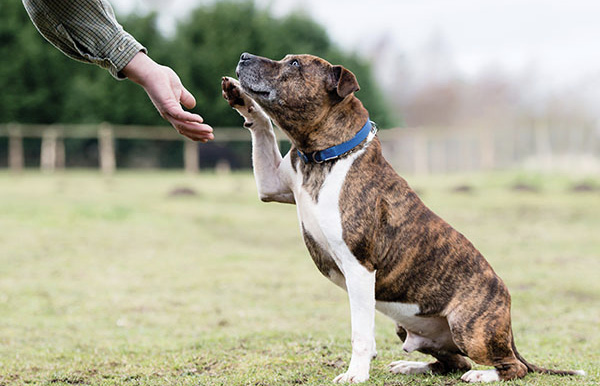
Problem:
My dog jumps on my guests, especially as they’re coming into my home.
Management Strategy: Breakfast in Bed
Remember this strategy from Chapter 3? Breakfast in Bed is an effective strategy for a dog who jumps on your guests as they enter or move about your home. By sending the dog to his crate or another room and entertaining him with a treat-dispensing toy, you’ve prevented the jumping and saved your guests from getting slobbered on.
Breakfast in Bed is often the first line of defense for overly enthusiastic greeters. Since the training methods that follow require some time to build up a dog’s impulse control, you can use Breakfast in Bed starting today. This management strategy does not “cure” the dog of his jumping because it doesn’t actually teach him to do anything polite. However, by removing your dog from the excitement of the front door, you are preventing the problem from escalating because he is not able to make a habit out of jumping on people. This, in turn, will make your training easier. See the instructions for Breakfast in Bed in Chapter 3.
Training Strategy 1: Sit for Greeting
Just as Sit for Greeting can be used for leashed walks, as already discussed in this chapter, it can be applied to indoor settings. I recommend putting your dog’s leash on while training this behavior, even indoors. This will give you more control over your dog’s body and allow you, if needed, to remove him from the entrance area if he can’t handle the excitement of the incoming guest. (If you need to remove him, you can switch to the Breakfast in Bed management strategy, which safely removes him from the action.) Once your pup has practiced Sit for Greeting thoroughly and has learned how to politely greet guests, you can remove the leash.
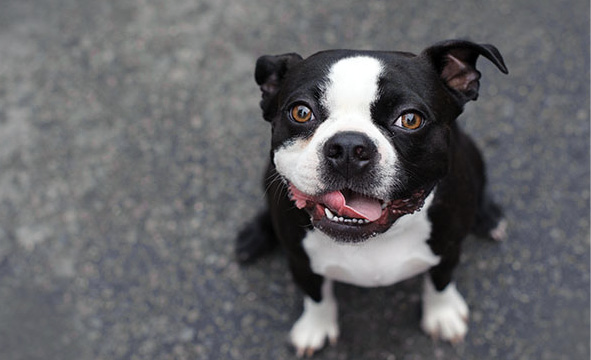
In the early stages of training a dog to be polite around houseguests, you can combine Breakfast in Bed and Sit for Greeting. When the doorbell rings, send the dog to the bedroom or crate and give him a food-stuffed toy while your guests come in and get settled. These few minutes are likely to be quite chaotic for your excitable dog, and he may not be able to sit (yet) in the presence of these new friends. It’s better to remove him than to put him in a situation in which he will fail at his training. Furthermore, it’s impossible for you to train a bouncy dog to sit while simultaneously greeting guests. What is Spot doing while your back is turned and you’re hugging your friend? Probably not sitting.
Once your guests have sat down and the energy is more relaxed, bring the dog out on leash, treats in hand. Now you have the attention span to focus on your dog, so training will proceed much more smoothly. With your dog on leash, approach the calmest guest first and practice Sit for Greeting as outlined earlier in this chapter. From there, take the dog to greet each guest individually. It’s possible that you will need to vary your rate of reinforcement (how quickly you treat during the Sit) for each guest. While sitting to greet the calmest guest, you might treat the dog every five seconds, but you may need to increase to treating every two seconds to greet an excitable guest. If you have a guest who will get your dog super-mega-excited, it is fine not to greet that guest at all.
Once your dog has calmed down, he can have the freedom to be off-leash in the presence of your guests, provided he can be polite. If you think he’ll try to climb into your great-grandmother’s lap or help himself to the hors-d’oeuvres on the coffee table, put his bed or mat next to your chair and have him go to his place there. (For full Place instructions, see Chapter 3.) This way, he can be a part of the action without actually being the action in the room.
Training Strategy 2: Place
Place, discussed in detail in Chapter 3, teaches your dog to go to his mat and stay there until released. This is an effective way to have your dog do something that is incompatible with jumping; if he’s sitting on his mat, he can’t be jumping. This behavior takes time for some dogs to perfect, so I recommend using a management strategy like Breakfast in Bed to remove your dog from the excitement until you have practiced Place many, many times.
Place is my go-to behavior when my friends and I are having dinner or watching a movie together. In these situations, the energy level in the room is usually manageable, so your dog will be calm enough to follow your instructions and remain on his place for a long period of time. The way I see it, your dog is part of the family, and he deserves to be included in group activities. By bringing his mat into the same room where you are, he gets the satisfaction of seeing what you and your friends are doing, and you have the ability to keep an eye on him. If your dog struggles to stay on his mat, give him a long-lasting treat, like a bully stick or a food-stuffed toy. This will keep him busy for an extended length of time while he is on his mat, making it a win-win for everyone.
